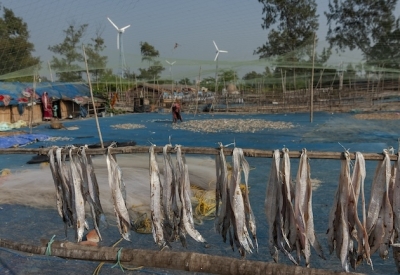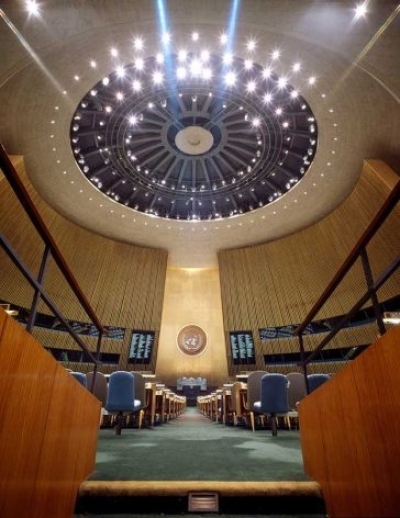This week, at least two drones have struck a skyscraper in Moscow, a sign that Ukraine is increasingly willing to take the war directly to Russia.
The building, which houses some government ministry offices, was initially damaged in a Sunday drone hit before a second on Tuesday. Russian defense officials accused Ukraine of perpetrating both, and said that both drones were “jammed” before crashing into the exact same skyscraper. Russian defense officials also said they intercepted two other drones outside Moscow overnight Tuesday, following a similar drone attack on Sunday in Moscow’s business district. On Thursday, regional authorities in Russia claimed it had shot down six Ukrainian drones outside of Moscow.
Ukraine has tended to be pretty coy regarding these kinds of attacks on Russian soil, but it was a bit more open about suggesting responsibility for the incidents earlier this week. “Gradually, the war is returning to the territory of Russia — to its symbolic centers and military bases, and this is an inevitable, natural and absolutely fair process,” President Volodymyr Zelenskyy said in a video address Sunday while avoiding outright ownership of the attack. In the aftermath of the apparent attack on Tuesday, Mykhailo Podolyak, an adviser to Zelenskyy, echoed that sentiment: “#Moscow is rapidly getting used to a full-fledged war, which, in turn, will soon finally move to the territory of the ‘authors of the war’ to collect all their debts ...”
Ukraine probably isn’t being quite as shy about this drone attack because it wants to send a message, and it wants Moscow to know who sent it. Ukraine is trying to raise the cost of war, and to make it more visible to the Russian people, particularly the elite and the establishment, who’ve largely been insulated from the consequences of Russia’s invasion.
“By bringing the war home to this business district in Moscow, of course, Ukraine makes the point that, well, life may go on in most of Russia, but Russia is at war, it’s a war Russia started — and the Putin government isn’t able to insulate its population or key elements of its population from the effects of the war,” said Niklas Masuhr, a military analyst at the Center for Security Studies at the Federal Institute of Technology Zurich.
The Ukrainian drones did not initially appear to do great damage or cause serious harm to civilians, but Ukraine is raising the specter that it could. Kremlin spokesperson Dmitri Peskov said Tuesday that the attacks were “a clear threat” and that measures are being taken to improve defense near the capital. But for the most part, Russian officials have downplayed the attacks. This is a bit of a repeat of what happened in May, after drones entered Moscow, including one that targeted the Kremlin.
Ukraine did not take public responsibility for that drone event, but Vladimir Putin largely framed it as Kyiv retaliating against Russia for its strategic missile strikes — that is, Ukraine was lashing out, which in Moscow’s view did not warrant a Russian escalation beyond what it was already doing.
What is different about this time is Kyiv is hinting that reaching inside Russia may become part of its wider strategy to counter the Kremlin. It’s not clear how much influence that will have on Russia, or on the battlefield and Ukraine’s ongoing counteroffensive. But messaging matter in war, and Ukraine is not being nearly as cagey about these attacks.
“The shiny face of business-friendly Moscow, open to the world, has been attacked, and the Russians couldn’t do anything about it. That’s very valuable as a symbol,” said Simon Schlegel, a senior analyst for Ukraine with the International Crisis Group.
A message to Moscow amid a contested counteroffensive
Ukrainian strikes or sabotage on Russian territory are nothing new. Kyiv has carried them out throughout the war, though they have tended to be in parts of Russia closer to the border with Ukraine, or in Russian-held Ukrainian territory, like Crimea. Favored targets include military bases, air fields, oil depots, rail lines, and other infrastructure and logistic hubs that allow Russia to wage its war.
Ukraine has mostly avoided taking direct responsibility for these attacks, staying quiet rather than celebrating any Russian setbacks. As one Ukrainian official said last year: “We don’t say yes and we don’t say no.” This strategic ambiguity, so to speak, is partly because these attacks are audacious and risk potential escalation with Moscow. Also, if Ukraine used any Western weapons to carry out these strikes, it could feed Putin’s narrative that the threat of NATO is fueling his Ukraine invasion. The US and its allies have, in the past, also indicated they do not want to enable or encourage Ukraine to hit within Russia.
These recent drone strikes in Moscow are more about optics than directly targeting Russia’s war logistics. But, of course, Russia is able to carry on this war because its public, and its elites, are insulated from the pain of it. It’s hard to know exactly what the Russian population thinks of the so-called special military operation, but it does seem that the majority support it, or at least aren’t actively opposed to it. That has flagged at moments when the war has been made real — think Putin’s mobilization effort last year, which prompted protests and people fleeing en masse. The Wagner rebellion also showed that Russian politics are not fully protected from battlefield setbacks. A few Moscow visits from Ukrainian drones pierces that armor, too.
The drones used in these attacks also seem to be homegrown, and a New York Times analysis found that Ukrainian-made models were used in these strikes on Moscow. Kyiv is scaling up its drone fleet, and this is a way to show it is investing in, developing, and expanding its own military capabilities amid war.
Federico Borsari, a Leonardo fellow with the Transatlantic Defense and Security Program at the Center for European Policy Analysis (CEPA), said that in some ways, Ukraine is mirroring what Russia has done, which is use drones — like those the Kremlin has purchased from Iran — to carry out attacks in Ukraine and penetrate Kyiv’s air defense systems. Russian drones have been used in recent attacks on a grain silo in Odesa and a critical river port on the Danube, which Ukraine will rely on to export agricultural products now that the Black Sea routes are effectively blockaded again.
“Ukraine is trying now to build the same type of capabilities — a cheap, long-range attack capability to target Russian objectives, deplete Russian air defenses,” Borsari said.
“It hasn’t the numbers yet to conduct this kind of attack at scale,” he added. “But I think, with time, we will see an increasing of this attack, and we will see more large-scale drone attacks by Ukraine against Russian targets, whether they are industrial complexes or military bases and the like.”
It seems unlikely that these recent drone attacks will fully change Putin’s calculus about the war, but it does communicate to Russia that Ukraine can increasingly strike Russian targets. That may force Russia to expend resources to try to protect different assets within Russia, which could stretch its military capabilities, especially as Ukraine wages its counteroffensive, which has shifted into a much more attritional conflict yet again.
From Ukraine’s perspective, a greater ability to wage war and defend itself is a success, one that Ukrainian officials are likely as happy to sell at home as they are eager to let Moscow know. “It’s not a silver bullet for winning the war,” said Borsari. “But this demonstrates that Ukraine could really integrate, and can use proficiently, all kinds of technology.”






